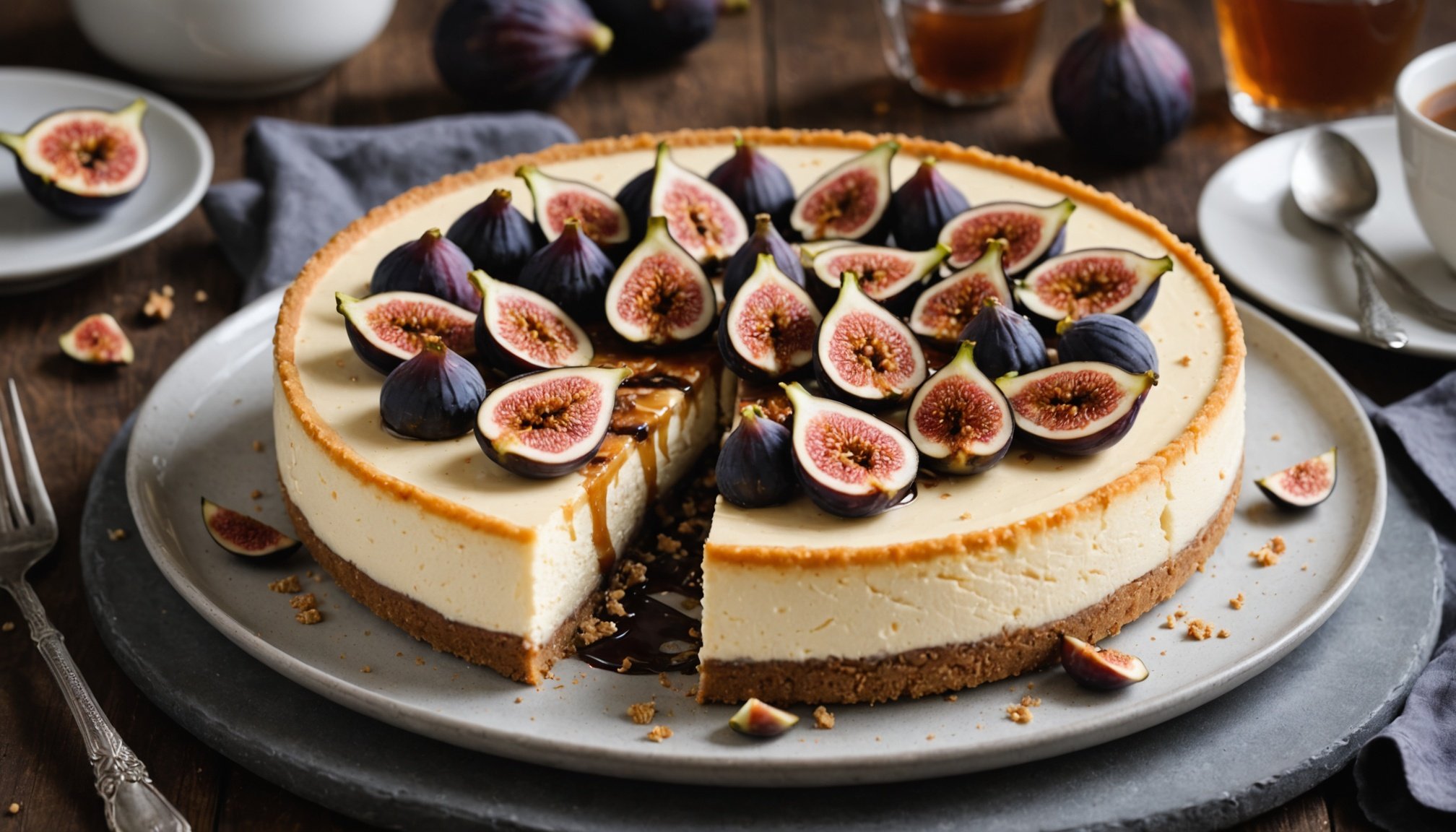The Essence of a Luxuriously Creamy Mascarpone and Fig Cheesecake
Luxurious cheesecake embodies a rich and velvety texture that distinguishes it from ordinary counterparts. Its creaminess stems from the use of high-quality mascarpone cheese, a creamy Italian cheese renowned for its smooth texture and subtle sweetness. Unlike typical cheesecakes, the inclusion of this decadent cheese elevates the dessert’s luxurious feel, offering a melt-in-the-mouth experience that is both indulgent and satisfying.
The selection of premium mascarpone cheese is crucial for achieving the desired level of creaminess. Its authentic flavour profile enhances the cheesecake without overpowering it, creating a harmonious balance of taste and texture.
Also to read : Discover the Ultimate Recipe for a Luxurious Sherry-Infused Creamy English Trifle!
Accompanying this luxurious base, figs play a dual role in the cheesecake’s allure. They not only amplify the flavour with their natural sweetness and slight nuttiness but also enhance the dessert’s presentation with their visual appeal. The figs can be prepared in various forms; whether mixed in the batter, used as a topping, or as a garnish, they add a touch of elegance and sophistication.
In essence, it is the combination of premium mascarpone cheese and figs that defines the true essence of this luxurious cheesecake.
Also to discover : Unveiling the secrets of the burger king mystery box
Essential Ingredients for the Perfect Cheesecake
When crafting the ultimate cheesecake masterpiece, start by ensuring you have the right cheesecake ingredients ready for action.
Gathering Your Ingredients
A classic cheesecake often leans heavily on a creamy base, where mascarpone plays a starring role. While mascarpone is traditionally favoured, feel free to explore alternatives like cream cheese for a slightly tangier profile. Fresh figs, in particular, can transform a cheesecake with their sweet and earthy notes, offering a delightful contrast to the rich base. If fresh figs aren’t available, consider high-quality dried figs as a backup. Sweeteners can also be swapped; consider honey, agave, or pure maple syrup, each adding a unique twist to the cheesecake ingredients palette.
Recommended Measurement Guidelines
Precision in measurement is key to achieving the desired cheesecake texture. Small deviations can alter consistency, so stick to exact quantities. Common conversions are helpful, especially when adapting recipes using grams or ounces. Choose organic ingredients for a purer taste and fewer additives, though conventional options work just as well.
Additional Flavor Enhancements
To elevate your cheesecake, contemplate adding zesty touches like citrus or a hint of vanilla for a deeper flavour. Texture can be enhanced with a nutty crust, such as pecans or almonds. For an adventurous twist, try infusing components like syrups or extracts. Indulging in these enhancements will ensure your cheesecake becomes a truly memorable culinary creation.
Techniques for Achieving Perfect Creamy Texture
Striving for the ideal cheesecake texture involves understanding several key creaminess techniques. One major factor is using ingredients that are at room temperature. Softened butter and cream cheese mix more smoothly, reducing lumps and creating a smoother batter. This is the foundation for achieving that luscious creaminess.
When it comes to the beating method, it’s crucial to incorporate air without overmixing. Beating your ingredients at medium speed allows air to blend in gently, enhancing the creaminess without forming cracks on the surface. Overmixing can lead to air pockets that cause cracks during baking. Utilizing a paddle attachment on your mixer helps avoid these pitfalls by mixing efficiently without aerating excessively.
To prevent cracks, consider using a water bath during baking. This keeps the baking environment humid, ensuring an evenly cooked cheesecake. Moreover, letting the cheesecake cool gradually after baking helps maintain its creamy structure.
Adopting intentional creaminess techniques like moderation in mixing and vigilant temperature control can be the difference between an ordinary and an exceptional cheesecake. By focusing on these aspects, home chefs can unleash the rich, smooth potential of their creations.
Step-by-Step Recipe to Master the Cheesecake
Embarking on this step-by-step guide to crafting the perfect cheesecake is as fulfilling as enjoying the final product. Let’s explore each part of the baking process to ensure your cheesecake stands out.
Preparing the Crust
Choosing the right base is crucial for a delectable cheesecake. The top crust options include graham crackers, cookies, or nuts. To achieve the ideal crust thickness, aim for a uniform layer about 1/8 inch deep. This thickness supports the filling without overpowering it. Pre-baking the crust at 175°C (350°F) for about 10 minutes ensures a crisp foundation, preventing sogginess once the cheesecake filling is added.
Making the Cheesecake Filling
Blending the filling requires a gentle touch. Begin by combining softened cream cheese and sugar until smooth. Gradually add eggs, one at a time, integrating each fully before the next. Finish with vanilla and lemon zest for a balanced flavor. It’s crucial to ensure the filling is free of lumps, maintaining a luxurious texture.
Baking and Cooling Process
Set your oven to 160°C (325°F) for optimal results. Create a water bath by placing the cheesecake pan inside a larger pan with hot water, which ensures even baking. Allow the cheesecake to cool gradually to maintain firmness, ideally overnight.
Presentation Tips for a Show-Stopping Dessert
Making your dessert visually appealing elevates the dining experience. A key aspect of dessert presentation is mastering the art of slicing. For a clean cut, use a hot, sharp knife, wiping it between slices. This technique is ideal for cheesecake, ensuring each piece looks even and enticing.
Once sliced, consider cheesecake garnishing to enhance appeal. Fresh figs or edible flowers add elegance and colour, making your dessert stand out. A dusting of icing sugar or a drizzle of fruit coulis can also elevate the appearance, offering both beauty and flavour.
Choosing the right serving dishes is crucial in creating an impactful display. A sleek porcelain platter or a glass cake stand can showcase your cake effectively, drawing focus to its presentation. For individual servings, using colourful dessert plates adds charm and excitement, making each slice feel special.
With these techniques for slicing, garnishing, and selecting serving dishes, you can ensure your dessert brings a touch of sophistication to any occasion. Whether it’s a festive gathering or an intimate dinner, these suggestions will help your cheesecake presentation leave a lasting impression.
Variations and Twists on the Classic Recipe
Exploring innovative takes on traditional cheesecake opens up a world of flavours and creativity. The classic recipe is a blank canvas for endless cheesecake variations and can be transformed with a few thoughtful tweaks.
Seasonal Variations
Infuse your cheesecake with the essence of the seasons by incorporating seasonal fruits like berries in summer or cranberries in winter. For an extra touch, add complementary flavours like lemon zest or a drizzle of caramel. On holidays, consider spices such as cinnamon or nutmeg to provide comforting warmth. These seasonal adjustments can make your cheesecake the highlight of any occasion.
Dietary Alternatives
For those with dietary restrictions, vegan and gluten-free adaptations are available, allowing everyone to enjoy this delicious treat. Use almond flour or gluten-free crackers for the crust and cashew or tofu-based fillings for a vegan spin. Opting for coconut or almond milk can address lactose intolerance issues successfully. Creative sugar substitutes like stevia or honey can cater to a healthier lifestyle without sacrificing flavour.
Utilizing Leftovers
Repurposing cheesecake remnants can lead to delightful surprises. Try using leftovers to craft other desserts like parfaits or as a rich filling in cookies. Store your surplus cheesecake properly in airtight containers to maintain its quality for future indulgence.
Anecdotes and History of Cheesecake
Cheesecake boasts a rich history, dating back to Ancient Greece where it delighted audiences at the first Olympic games. Ancient Greeks regarded it as an essential energy booster, appreciating its simple yet nutritional composition. As cheesecake’s fame spread, each culture added its unique twist, weaving this dessert into various culinary traditions worldwide.
In Roman times, cheesecake recipes evolved, blending new ingredients to appeal to the Roman palate. Fast forward to medieval Europe, and you’d find evolving cheesecake variations reflecting regional tastes. This dessert transcended mere sustenance, turning into a symbol of luxury and celebration. Some cultures embraced cheesecake exclusively during special occasions, associating it with abundance and festivity.
Throughout its journey across different continents, cheesecake adapted to local essences and ingredients, adding layers of complexity and intrigue. In America, it gained notoriety as New York-style cheesecake became synonymous with indulgence.
Many people possess fond memories of cheesecake, often recalling cherished family gatherings where this dessert reigned supreme. Whether serving as a birthday centerpiece or a complement to joyous occasions, cheesecake’s versatility is undeniable. From ancient Olympic feasts to modern-day celebrations, cheesecake continues to captivate palates, solidifying its place within the world of dessert traditions.











